Strategic and Operational Management: Stakeholder & Dynamics
VerifiedAdded on 2020/04/01
|16
|3498
|120
Report
AI Summary
This report provides a comprehensive overview of strategic and operational management, exploring various approaches such as stakeholder management, dynamic capabilities, and sustainability. It delves into the principles of strategic management, including the linear model, and examines the limitations of these approaches. The report analyzes how companies like Coca-Cola and Apple utilize stakeholder and dynamic capabilities approaches, respectively, to achieve business success. It also discusses the importance of sustainable development and corporate social responsibility. The report emphasizes the need for systematic implementation of these approaches to drive organizational benefits and ensure long-term viability, offering valuable insights for effective management practices.
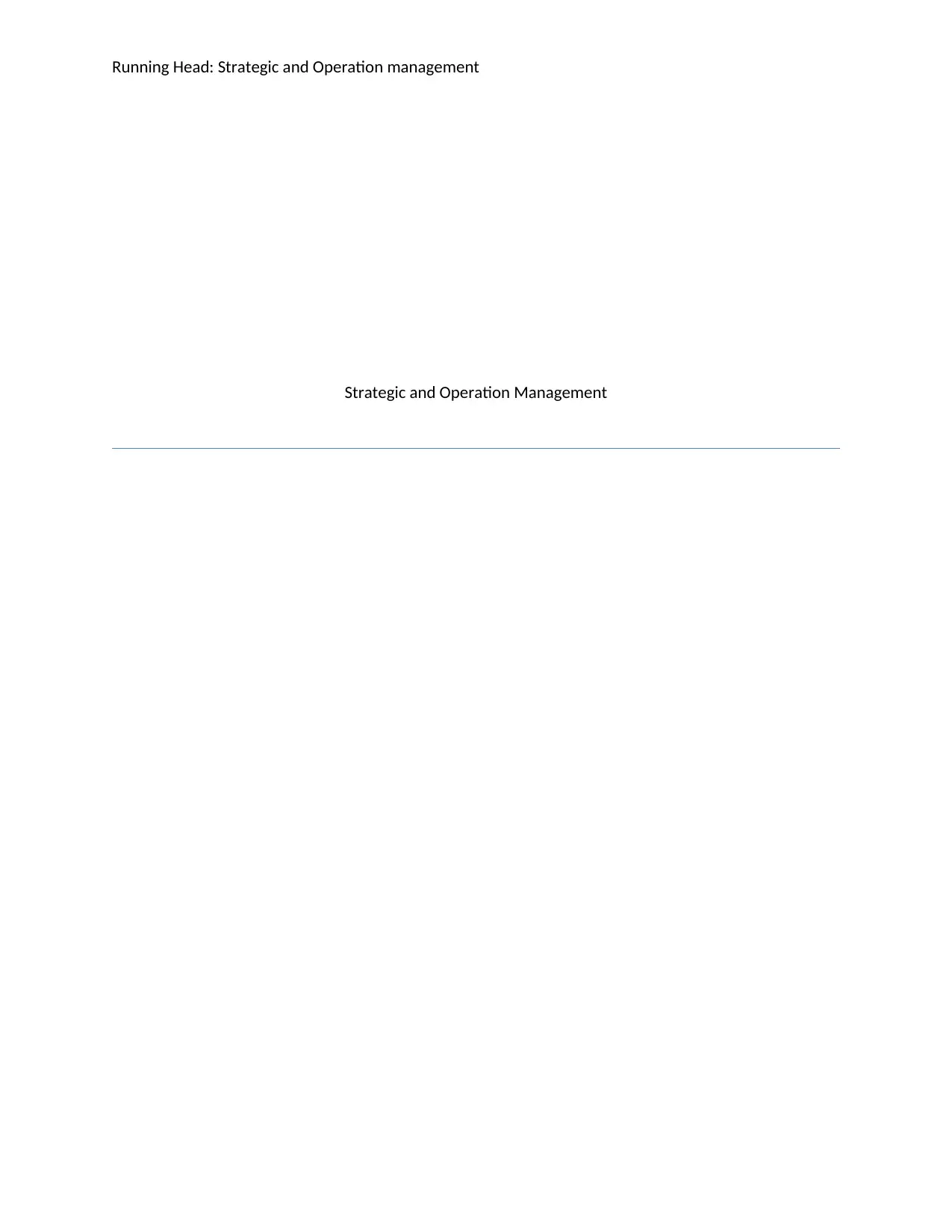
Running Head: Strategic and Operation management
Strategic and Operation Management
Strategic and Operation Management
Paraphrase This Document
Need a fresh take? Get an instant paraphrase of this document with our AI Paraphraser
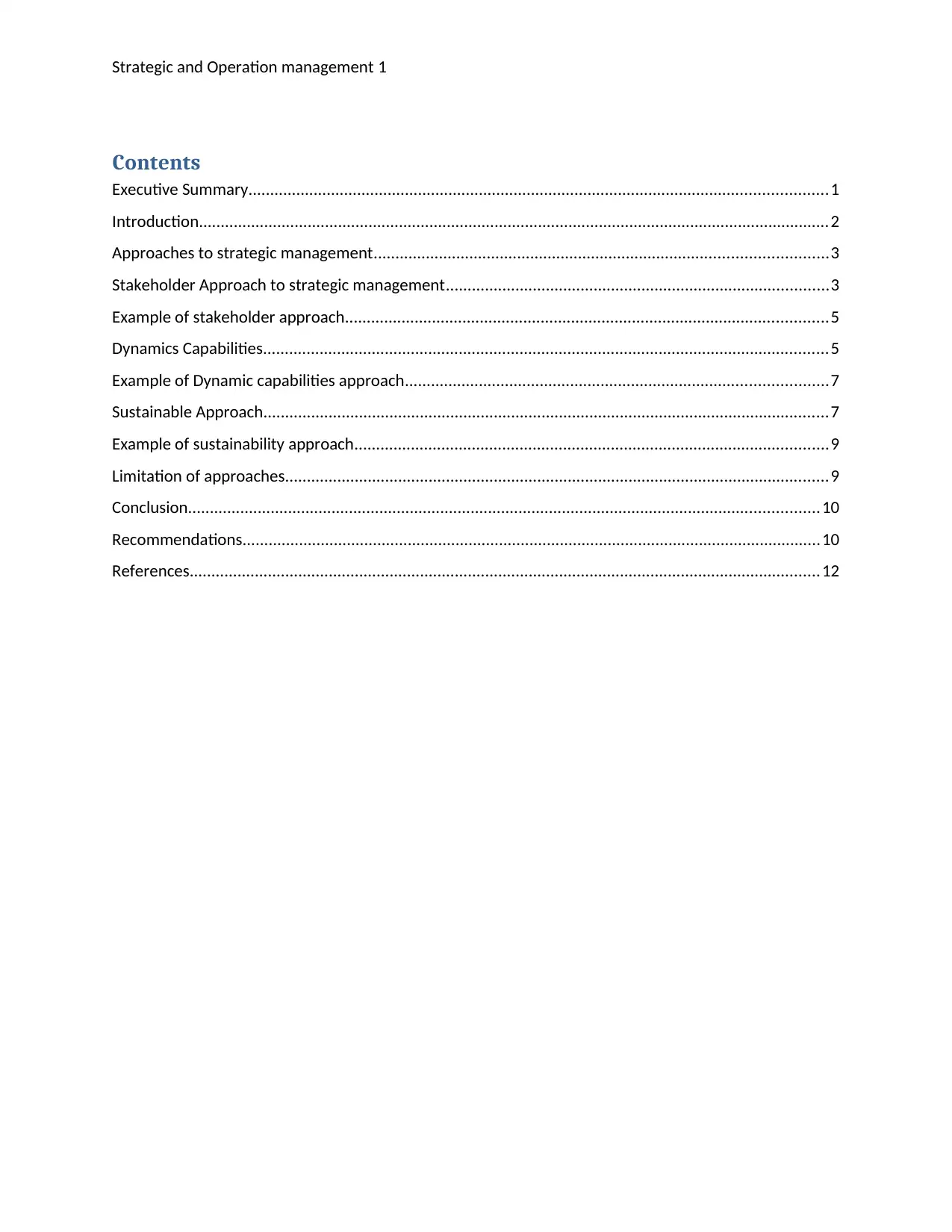
Strategic and Operation management 1
Contents
Executive Summary.....................................................................................................................................1
Introduction.................................................................................................................................................2
Approaches to strategic management........................................................................................................3
Stakeholder Approach to strategic management........................................................................................3
Example of stakeholder approach...............................................................................................................5
Dynamics Capabilities..................................................................................................................................5
Example of Dynamic capabilities approach.................................................................................................7
Sustainable Approach..................................................................................................................................7
Example of sustainability approach.............................................................................................................9
Limitation of approaches.............................................................................................................................9
Conclusion.................................................................................................................................................10
Recommendations.....................................................................................................................................10
References.................................................................................................................................................12
Contents
Executive Summary.....................................................................................................................................1
Introduction.................................................................................................................................................2
Approaches to strategic management........................................................................................................3
Stakeholder Approach to strategic management........................................................................................3
Example of stakeholder approach...............................................................................................................5
Dynamics Capabilities..................................................................................................................................5
Example of Dynamic capabilities approach.................................................................................................7
Sustainable Approach..................................................................................................................................7
Example of sustainability approach.............................................................................................................9
Limitation of approaches.............................................................................................................................9
Conclusion.................................................................................................................................................10
Recommendations.....................................................................................................................................10
References.................................................................................................................................................12
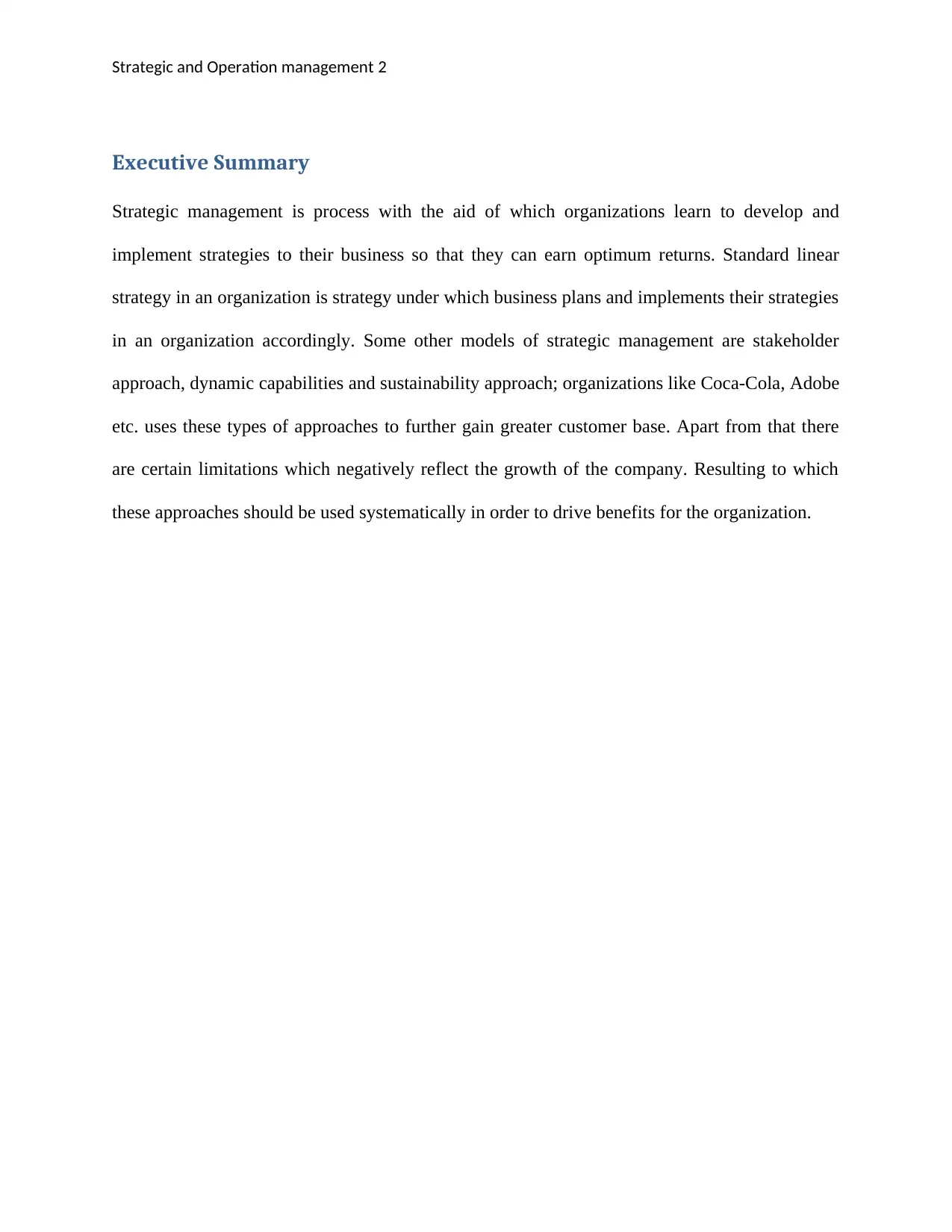
Strategic and Operation management 2
Executive Summary
Strategic management is process with the aid of which organizations learn to develop and
implement strategies to their business so that they can earn optimum returns. Standard linear
strategy in an organization is strategy under which business plans and implements their strategies
in an organization accordingly. Some other models of strategic management are stakeholder
approach, dynamic capabilities and sustainability approach; organizations like Coca-Cola, Adobe
etc. uses these types of approaches to further gain greater customer base. Apart from that there
are certain limitations which negatively reflect the growth of the company. Resulting to which
these approaches should be used systematically in order to drive benefits for the organization.
Executive Summary
Strategic management is process with the aid of which organizations learn to develop and
implement strategies to their business so that they can earn optimum returns. Standard linear
strategy in an organization is strategy under which business plans and implements their strategies
in an organization accordingly. Some other models of strategic management are stakeholder
approach, dynamic capabilities and sustainability approach; organizations like Coca-Cola, Adobe
etc. uses these types of approaches to further gain greater customer base. Apart from that there
are certain limitations which negatively reflect the growth of the company. Resulting to which
these approaches should be used systematically in order to drive benefits for the organization.
⊘ This is a preview!⊘
Do you want full access?
Subscribe today to unlock all pages.

Trusted by 1+ million students worldwide
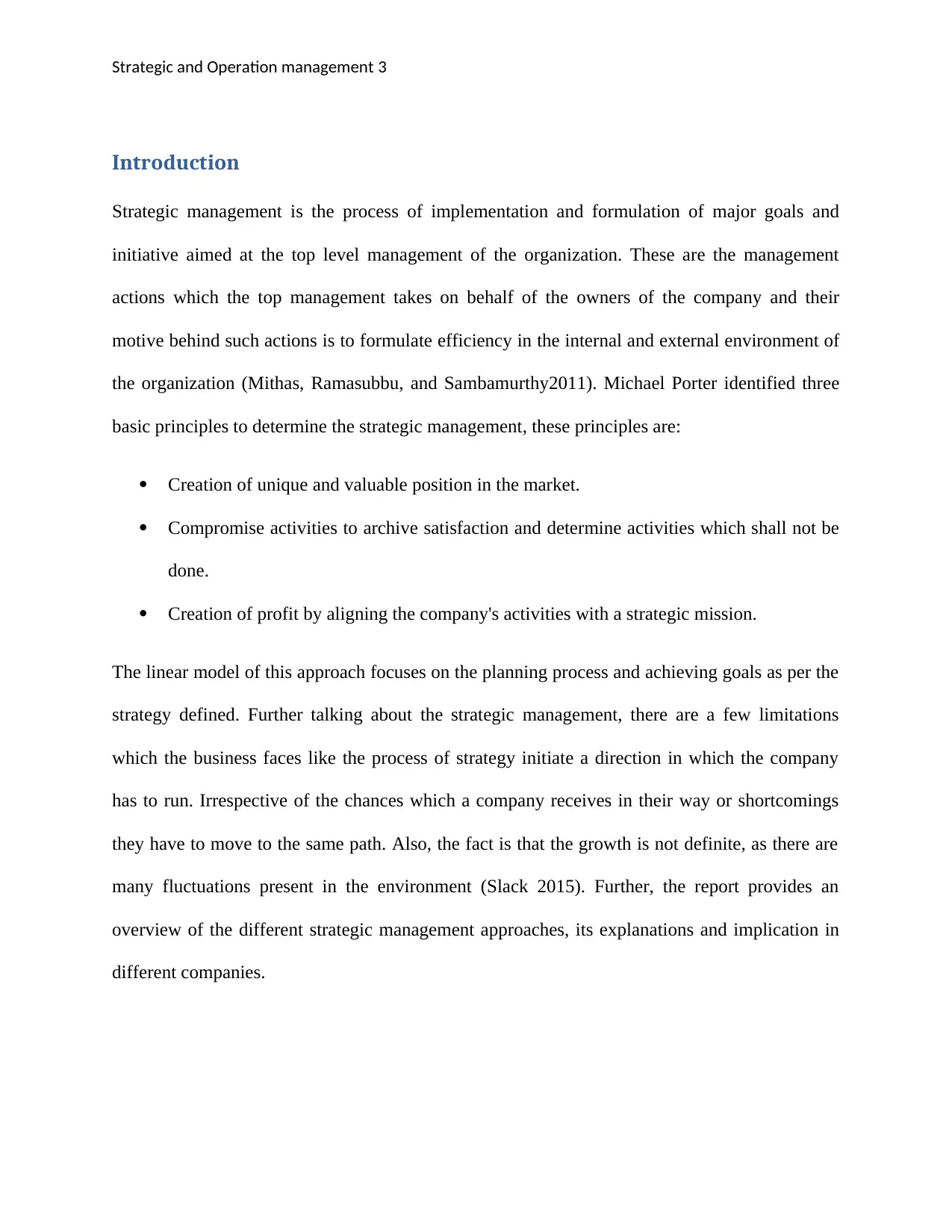
Strategic and Operation management 3
Introduction
Strategic management is the process of implementation and formulation of major goals and
initiative aimed at the top level management of the organization. These are the management
actions which the top management takes on behalf of the owners of the company and their
motive behind such actions is to formulate efficiency in the internal and external environment of
the organization (Mithas, Ramasubbu, and Sambamurthy2011). Michael Porter identified three
basic principles to determine the strategic management, these principles are:
Creation of unique and valuable position in the market.
Compromise activities to archive satisfaction and determine activities which shall not be
done.
Creation of profit by aligning the company's activities with a strategic mission.
The linear model of this approach focuses on the planning process and achieving goals as per the
strategy defined. Further talking about the strategic management, there are a few limitations
which the business faces like the process of strategy initiate a direction in which the company
has to run. Irrespective of the chances which a company receives in their way or shortcomings
they have to move to the same path. Also, the fact is that the growth is not definite, as there are
many fluctuations present in the environment (Slack 2015). Further, the report provides an
overview of the different strategic management approaches, its explanations and implication in
different companies.
Introduction
Strategic management is the process of implementation and formulation of major goals and
initiative aimed at the top level management of the organization. These are the management
actions which the top management takes on behalf of the owners of the company and their
motive behind such actions is to formulate efficiency in the internal and external environment of
the organization (Mithas, Ramasubbu, and Sambamurthy2011). Michael Porter identified three
basic principles to determine the strategic management, these principles are:
Creation of unique and valuable position in the market.
Compromise activities to archive satisfaction and determine activities which shall not be
done.
Creation of profit by aligning the company's activities with a strategic mission.
The linear model of this approach focuses on the planning process and achieving goals as per the
strategy defined. Further talking about the strategic management, there are a few limitations
which the business faces like the process of strategy initiate a direction in which the company
has to run. Irrespective of the chances which a company receives in their way or shortcomings
they have to move to the same path. Also, the fact is that the growth is not definite, as there are
many fluctuations present in the environment (Slack 2015). Further, the report provides an
overview of the different strategic management approaches, its explanations and implication in
different companies.
Paraphrase This Document
Need a fresh take? Get an instant paraphrase of this document with our AI Paraphraser
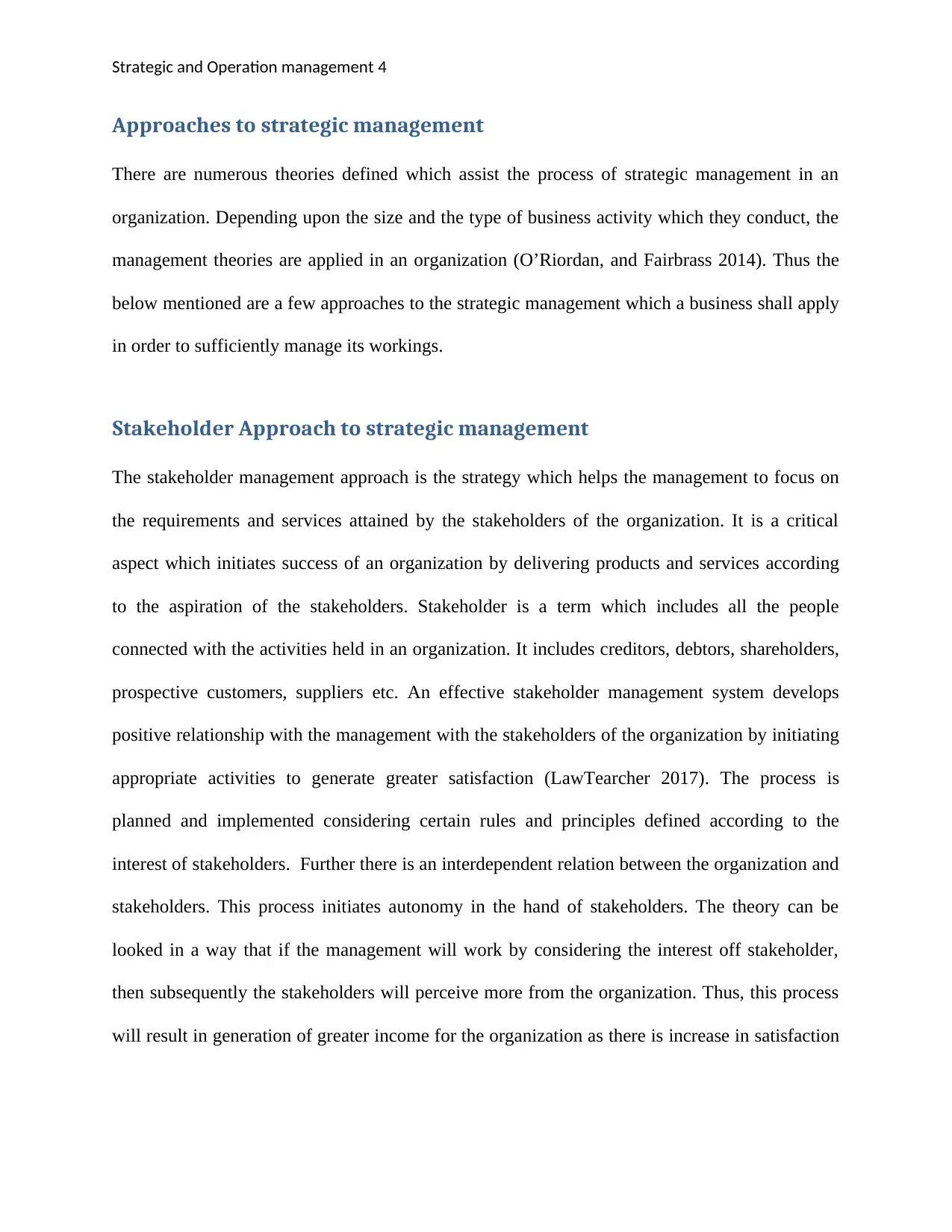
Strategic and Operation management 4
Approaches to strategic management
There are numerous theories defined which assist the process of strategic management in an
organization. Depending upon the size and the type of business activity which they conduct, the
management theories are applied in an organization (O’Riordan, and Fairbrass 2014). Thus the
below mentioned are a few approaches to the strategic management which a business shall apply
in order to sufficiently manage its workings.
Stakeholder Approach to strategic management
The stakeholder management approach is the strategy which helps the management to focus on
the requirements and services attained by the stakeholders of the organization. It is a critical
aspect which initiates success of an organization by delivering products and services according
to the aspiration of the stakeholders. Stakeholder is a term which includes all the people
connected with the activities held in an organization. It includes creditors, debtors, shareholders,
prospective customers, suppliers etc. An effective stakeholder management system develops
positive relationship with the management with the stakeholders of the organization by initiating
appropriate activities to generate greater satisfaction (LawTearcher 2017). The process is
planned and implemented considering certain rules and principles defined according to the
interest of stakeholders. Further there is an interdependent relation between the organization and
stakeholders. This process initiates autonomy in the hand of stakeholders. The theory can be
looked in a way that if the management will work by considering the interest off stakeholder,
then subsequently the stakeholders will perceive more from the organization. Thus, this process
will result in generation of greater income for the organization as there is increase in satisfaction
Approaches to strategic management
There are numerous theories defined which assist the process of strategic management in an
organization. Depending upon the size and the type of business activity which they conduct, the
management theories are applied in an organization (O’Riordan, and Fairbrass 2014). Thus the
below mentioned are a few approaches to the strategic management which a business shall apply
in order to sufficiently manage its workings.
Stakeholder Approach to strategic management
The stakeholder management approach is the strategy which helps the management to focus on
the requirements and services attained by the stakeholders of the organization. It is a critical
aspect which initiates success of an organization by delivering products and services according
to the aspiration of the stakeholders. Stakeholder is a term which includes all the people
connected with the activities held in an organization. It includes creditors, debtors, shareholders,
prospective customers, suppliers etc. An effective stakeholder management system develops
positive relationship with the management with the stakeholders of the organization by initiating
appropriate activities to generate greater satisfaction (LawTearcher 2017). The process is
planned and implemented considering certain rules and principles defined according to the
interest of stakeholders. Further there is an interdependent relation between the organization and
stakeholders. This process initiates autonomy in the hand of stakeholders. The theory can be
looked in a way that if the management will work by considering the interest off stakeholder,
then subsequently the stakeholders will perceive more from the organization. Thus, this process
will result in generation of greater income for the organization as there is increase in satisfaction
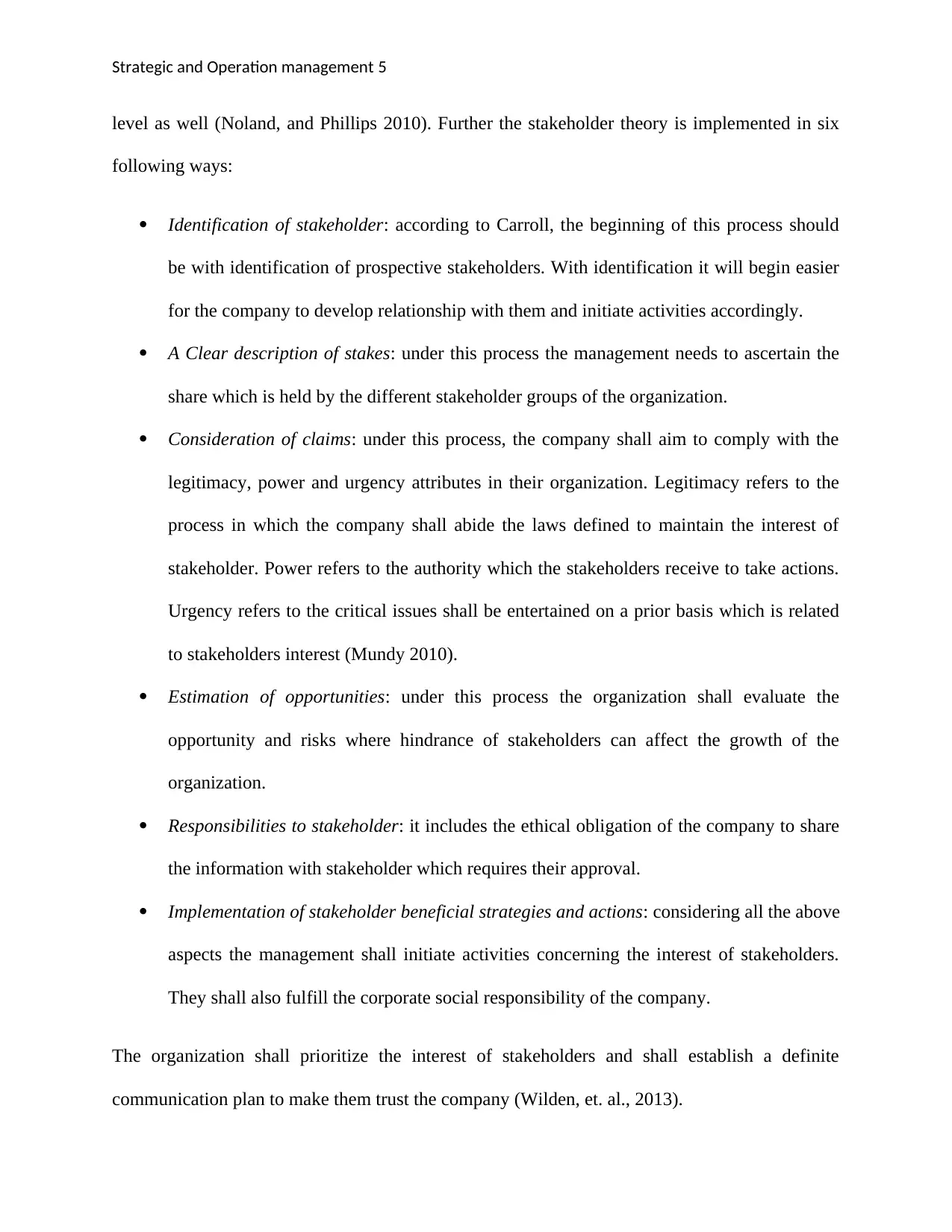
Strategic and Operation management 5
level as well (Noland, and Phillips 2010). Further the stakeholder theory is implemented in six
following ways:
Identification of stakeholder: according to Carroll, the beginning of this process should
be with identification of prospective stakeholders. With identification it will begin easier
for the company to develop relationship with them and initiate activities accordingly.
A Clear description of stakes: under this process the management needs to ascertain the
share which is held by the different stakeholder groups of the organization.
Consideration of claims: under this process, the company shall aim to comply with the
legitimacy, power and urgency attributes in their organization. Legitimacy refers to the
process in which the company shall abide the laws defined to maintain the interest of
stakeholder. Power refers to the authority which the stakeholders receive to take actions.
Urgency refers to the critical issues shall be entertained on a prior basis which is related
to stakeholders interest (Mundy 2010).
Estimation of opportunities: under this process the organization shall evaluate the
opportunity and risks where hindrance of stakeholders can affect the growth of the
organization.
Responsibilities to stakeholder: it includes the ethical obligation of the company to share
the information with stakeholder which requires their approval.
Implementation of stakeholder beneficial strategies and actions: considering all the above
aspects the management shall initiate activities concerning the interest of stakeholders.
They shall also fulfill the corporate social responsibility of the company.
The organization shall prioritize the interest of stakeholders and shall establish a definite
communication plan to make them trust the company (Wilden, et. al., 2013).
level as well (Noland, and Phillips 2010). Further the stakeholder theory is implemented in six
following ways:
Identification of stakeholder: according to Carroll, the beginning of this process should
be with identification of prospective stakeholders. With identification it will begin easier
for the company to develop relationship with them and initiate activities accordingly.
A Clear description of stakes: under this process the management needs to ascertain the
share which is held by the different stakeholder groups of the organization.
Consideration of claims: under this process, the company shall aim to comply with the
legitimacy, power and urgency attributes in their organization. Legitimacy refers to the
process in which the company shall abide the laws defined to maintain the interest of
stakeholder. Power refers to the authority which the stakeholders receive to take actions.
Urgency refers to the critical issues shall be entertained on a prior basis which is related
to stakeholders interest (Mundy 2010).
Estimation of opportunities: under this process the organization shall evaluate the
opportunity and risks where hindrance of stakeholders can affect the growth of the
organization.
Responsibilities to stakeholder: it includes the ethical obligation of the company to share
the information with stakeholder which requires their approval.
Implementation of stakeholder beneficial strategies and actions: considering all the above
aspects the management shall initiate activities concerning the interest of stakeholders.
They shall also fulfill the corporate social responsibility of the company.
The organization shall prioritize the interest of stakeholders and shall establish a definite
communication plan to make them trust the company (Wilden, et. al., 2013).
⊘ This is a preview!⊘
Do you want full access?
Subscribe today to unlock all pages.

Trusted by 1+ million students worldwide
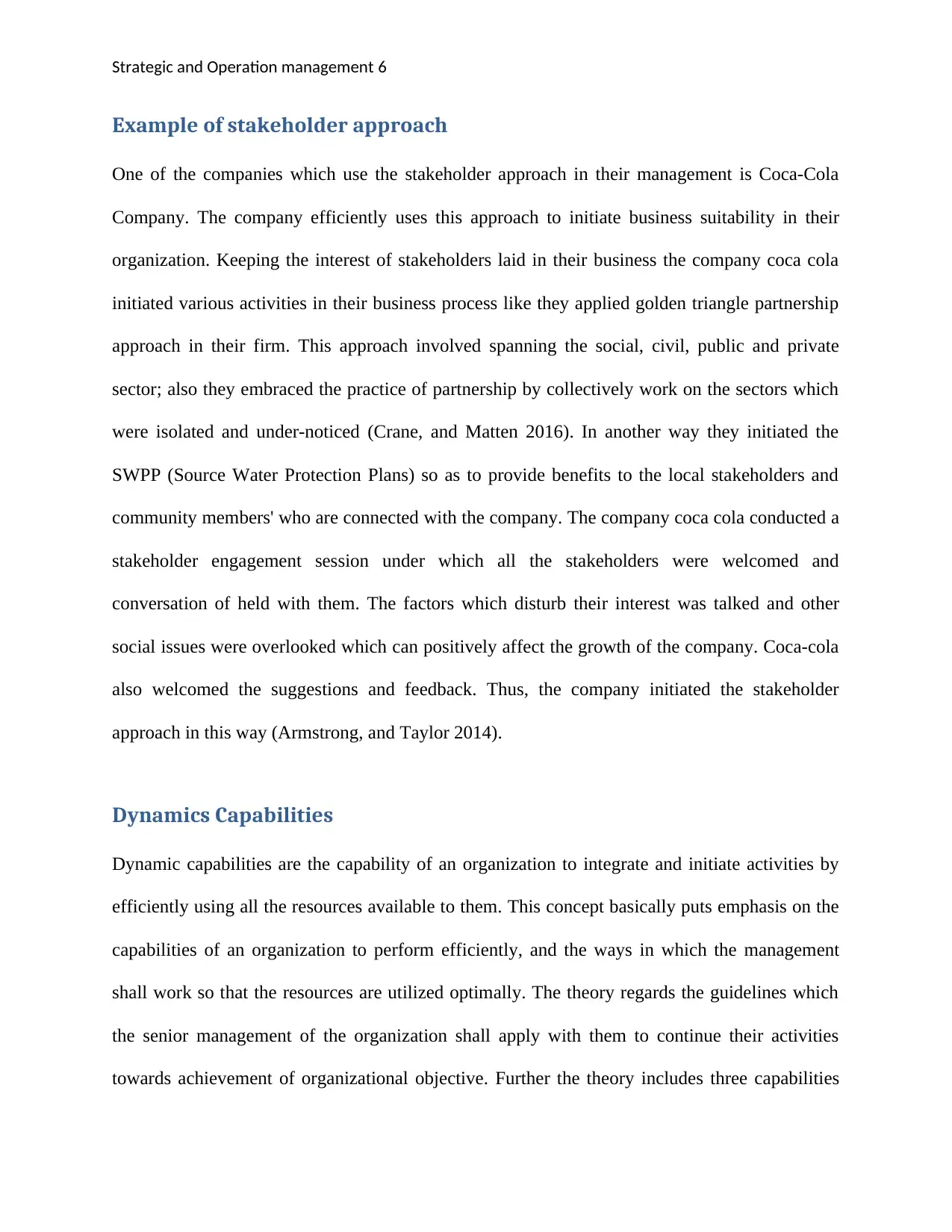
Strategic and Operation management 6
Example of stakeholder approach
One of the companies which use the stakeholder approach in their management is Coca-Cola
Company. The company efficiently uses this approach to initiate business suitability in their
organization. Keeping the interest of stakeholders laid in their business the company coca cola
initiated various activities in their business process like they applied golden triangle partnership
approach in their firm. This approach involved spanning the social, civil, public and private
sector; also they embraced the practice of partnership by collectively work on the sectors which
were isolated and under-noticed (Crane, and Matten 2016). In another way they initiated the
SWPP (Source Water Protection Plans) so as to provide benefits to the local stakeholders and
community members' who are connected with the company. The company coca cola conducted a
stakeholder engagement session under which all the stakeholders were welcomed and
conversation of held with them. The factors which disturb their interest was talked and other
social issues were overlooked which can positively affect the growth of the company. Coca-cola
also welcomed the suggestions and feedback. Thus, the company initiated the stakeholder
approach in this way (Armstrong, and Taylor 2014).
Dynamics Capabilities
Dynamic capabilities are the capability of an organization to integrate and initiate activities by
efficiently using all the resources available to them. This concept basically puts emphasis on the
capabilities of an organization to perform efficiently, and the ways in which the management
shall work so that the resources are utilized optimally. The theory regards the guidelines which
the senior management of the organization shall apply with them to continue their activities
towards achievement of organizational objective. Further the theory includes three capabilities
Example of stakeholder approach
One of the companies which use the stakeholder approach in their management is Coca-Cola
Company. The company efficiently uses this approach to initiate business suitability in their
organization. Keeping the interest of stakeholders laid in their business the company coca cola
initiated various activities in their business process like they applied golden triangle partnership
approach in their firm. This approach involved spanning the social, civil, public and private
sector; also they embraced the practice of partnership by collectively work on the sectors which
were isolated and under-noticed (Crane, and Matten 2016). In another way they initiated the
SWPP (Source Water Protection Plans) so as to provide benefits to the local stakeholders and
community members' who are connected with the company. The company coca cola conducted a
stakeholder engagement session under which all the stakeholders were welcomed and
conversation of held with them. The factors which disturb their interest was talked and other
social issues were overlooked which can positively affect the growth of the company. Coca-cola
also welcomed the suggestions and feedback. Thus, the company initiated the stakeholder
approach in this way (Armstrong, and Taylor 2014).
Dynamics Capabilities
Dynamic capabilities are the capability of an organization to integrate and initiate activities by
efficiently using all the resources available to them. This concept basically puts emphasis on the
capabilities of an organization to perform efficiently, and the ways in which the management
shall work so that the resources are utilized optimally. The theory regards the guidelines which
the senior management of the organization shall apply with them to continue their activities
towards achievement of organizational objective. Further the theory includes three capabilities
Paraphrase This Document
Need a fresh take? Get an instant paraphrase of this document with our AI Paraphraser
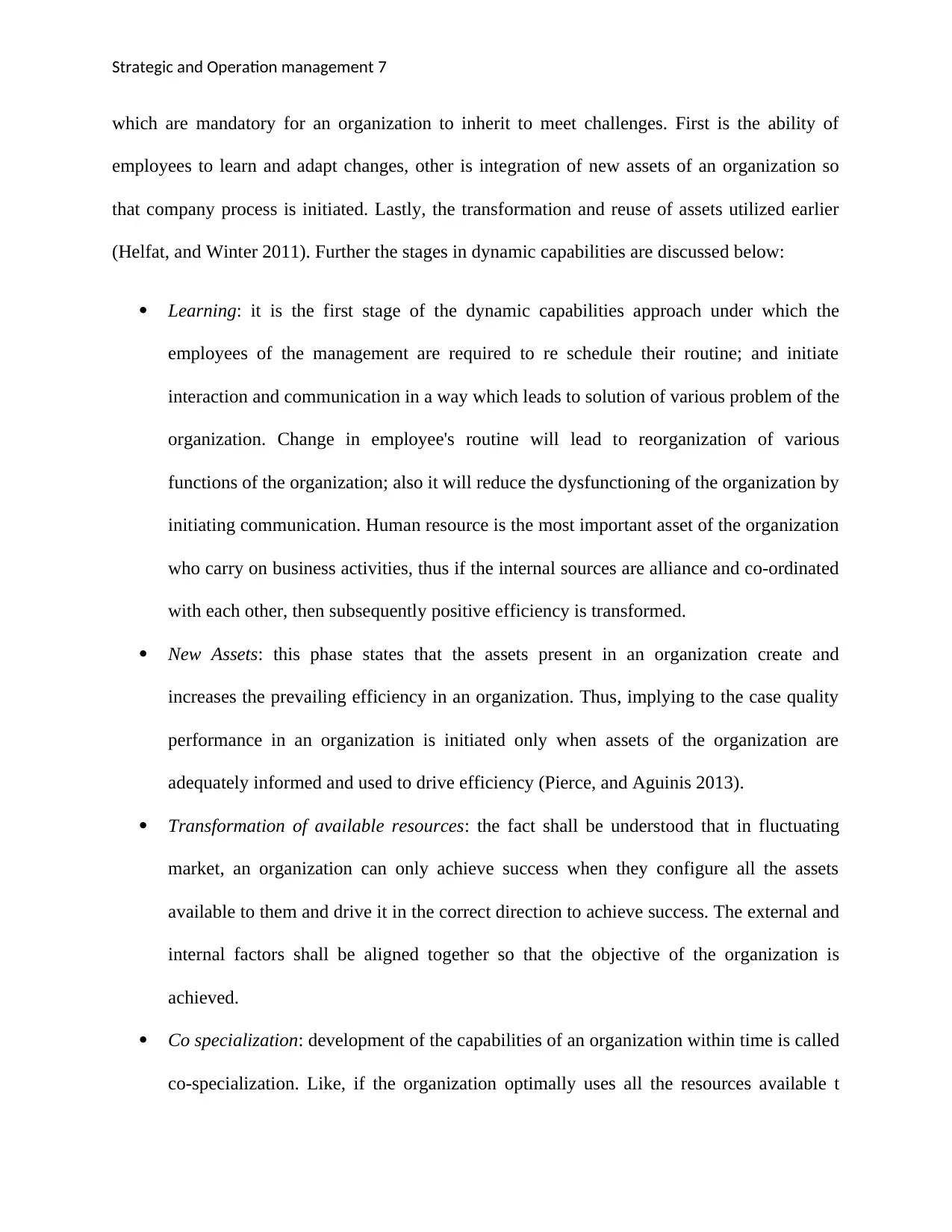
Strategic and Operation management 7
which are mandatory for an organization to inherit to meet challenges. First is the ability of
employees to learn and adapt changes, other is integration of new assets of an organization so
that company process is initiated. Lastly, the transformation and reuse of assets utilized earlier
(Helfat, and Winter 2011). Further the stages in dynamic capabilities are discussed below:
Learning: it is the first stage of the dynamic capabilities approach under which the
employees of the management are required to re schedule their routine; and initiate
interaction and communication in a way which leads to solution of various problem of the
organization. Change in employee's routine will lead to reorganization of various
functions of the organization; also it will reduce the dysfunctioning of the organization by
initiating communication. Human resource is the most important asset of the organization
who carry on business activities, thus if the internal sources are alliance and co-ordinated
with each other, then subsequently positive efficiency is transformed.
New Assets: this phase states that the assets present in an organization create and
increases the prevailing efficiency in an organization. Thus, implying to the case quality
performance in an organization is initiated only when assets of the organization are
adequately informed and used to drive efficiency (Pierce, and Aguinis 2013).
Transformation of available resources: the fact shall be understood that in fluctuating
market, an organization can only achieve success when they configure all the assets
available to them and drive it in the correct direction to achieve success. The external and
internal factors shall be aligned together so that the objective of the organization is
achieved.
Co specialization: development of the capabilities of an organization within time is called
co-specialization. Like, if the organization optimally uses all the resources available t
which are mandatory for an organization to inherit to meet challenges. First is the ability of
employees to learn and adapt changes, other is integration of new assets of an organization so
that company process is initiated. Lastly, the transformation and reuse of assets utilized earlier
(Helfat, and Winter 2011). Further the stages in dynamic capabilities are discussed below:
Learning: it is the first stage of the dynamic capabilities approach under which the
employees of the management are required to re schedule their routine; and initiate
interaction and communication in a way which leads to solution of various problem of the
organization. Change in employee's routine will lead to reorganization of various
functions of the organization; also it will reduce the dysfunctioning of the organization by
initiating communication. Human resource is the most important asset of the organization
who carry on business activities, thus if the internal sources are alliance and co-ordinated
with each other, then subsequently positive efficiency is transformed.
New Assets: this phase states that the assets present in an organization create and
increases the prevailing efficiency in an organization. Thus, implying to the case quality
performance in an organization is initiated only when assets of the organization are
adequately informed and used to drive efficiency (Pierce, and Aguinis 2013).
Transformation of available resources: the fact shall be understood that in fluctuating
market, an organization can only achieve success when they configure all the assets
available to them and drive it in the correct direction to achieve success. The external and
internal factors shall be aligned together so that the objective of the organization is
achieved.
Co specialization: development of the capabilities of an organization within time is called
co-specialization. Like, if the organization optimally uses all the resources available t
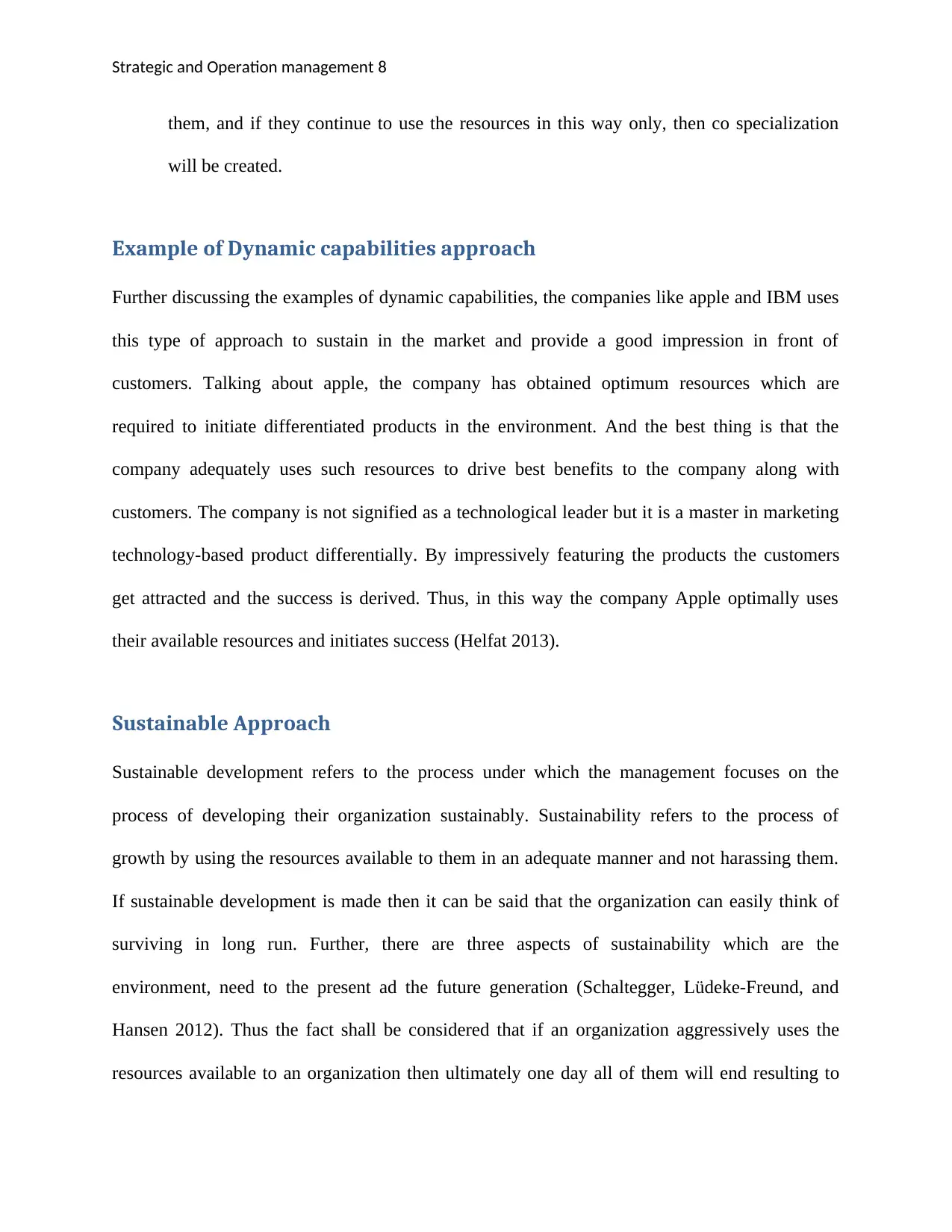
Strategic and Operation management 8
them, and if they continue to use the resources in this way only, then co specialization
will be created.
Example of Dynamic capabilities approach
Further discussing the examples of dynamic capabilities, the companies like apple and IBM uses
this type of approach to sustain in the market and provide a good impression in front of
customers. Talking about apple, the company has obtained optimum resources which are
required to initiate differentiated products in the environment. And the best thing is that the
company adequately uses such resources to drive best benefits to the company along with
customers. The company is not signified as a technological leader but it is a master in marketing
technology-based product differentially. By impressively featuring the products the customers
get attracted and the success is derived. Thus, in this way the company Apple optimally uses
their available resources and initiates success (Helfat 2013).
Sustainable Approach
Sustainable development refers to the process under which the management focuses on the
process of developing their organization sustainably. Sustainability refers to the process of
growth by using the resources available to them in an adequate manner and not harassing them.
If sustainable development is made then it can be said that the organization can easily think of
surviving in long run. Further, there are three aspects of sustainability which are the
environment, need to the present ad the future generation (Schaltegger, Lüdeke-Freund, and
Hansen 2012). Thus the fact shall be considered that if an organization aggressively uses the
resources available to an organization then ultimately one day all of them will end resulting to
them, and if they continue to use the resources in this way only, then co specialization
will be created.
Example of Dynamic capabilities approach
Further discussing the examples of dynamic capabilities, the companies like apple and IBM uses
this type of approach to sustain in the market and provide a good impression in front of
customers. Talking about apple, the company has obtained optimum resources which are
required to initiate differentiated products in the environment. And the best thing is that the
company adequately uses such resources to drive best benefits to the company along with
customers. The company is not signified as a technological leader but it is a master in marketing
technology-based product differentially. By impressively featuring the products the customers
get attracted and the success is derived. Thus, in this way the company Apple optimally uses
their available resources and initiates success (Helfat 2013).
Sustainable Approach
Sustainable development refers to the process under which the management focuses on the
process of developing their organization sustainably. Sustainability refers to the process of
growth by using the resources available to them in an adequate manner and not harassing them.
If sustainable development is made then it can be said that the organization can easily think of
surviving in long run. Further, there are three aspects of sustainability which are the
environment, need to the present ad the future generation (Schaltegger, Lüdeke-Freund, and
Hansen 2012). Thus the fact shall be considered that if an organization aggressively uses the
resources available to an organization then ultimately one day all of them will end resulting to
⊘ This is a preview!⊘
Do you want full access?
Subscribe today to unlock all pages.

Trusted by 1+ million students worldwide
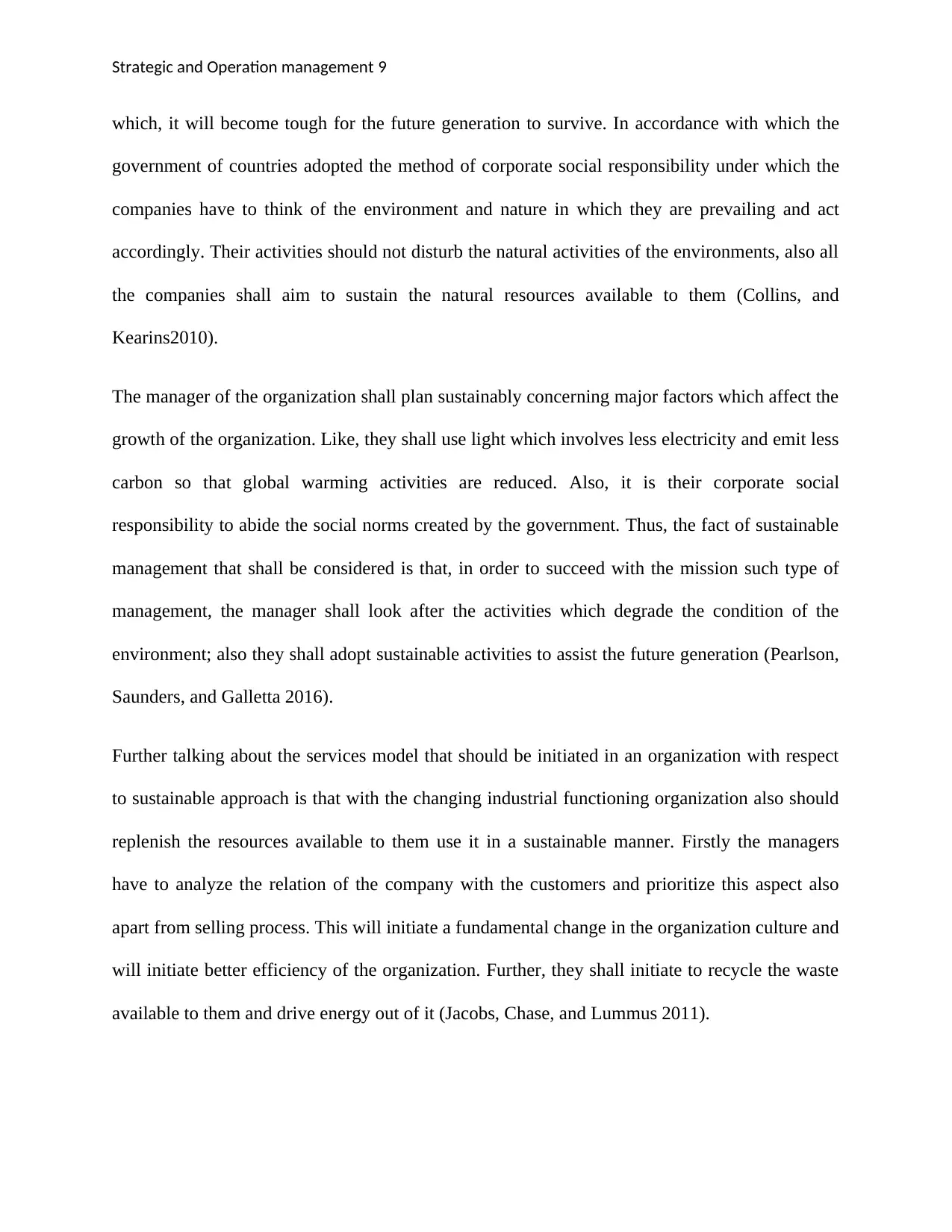
Strategic and Operation management 9
which, it will become tough for the future generation to survive. In accordance with which the
government of countries adopted the method of corporate social responsibility under which the
companies have to think of the environment and nature in which they are prevailing and act
accordingly. Their activities should not disturb the natural activities of the environments, also all
the companies shall aim to sustain the natural resources available to them (Collins, and
Kearins2010).
The manager of the organization shall plan sustainably concerning major factors which affect the
growth of the organization. Like, they shall use light which involves less electricity and emit less
carbon so that global warming activities are reduced. Also, it is their corporate social
responsibility to abide the social norms created by the government. Thus, the fact of sustainable
management that shall be considered is that, in order to succeed with the mission such type of
management, the manager shall look after the activities which degrade the condition of the
environment; also they shall adopt sustainable activities to assist the future generation (Pearlson,
Saunders, and Galletta 2016).
Further talking about the services model that should be initiated in an organization with respect
to sustainable approach is that with the changing industrial functioning organization also should
replenish the resources available to them use it in a sustainable manner. Firstly the managers
have to analyze the relation of the company with the customers and prioritize this aspect also
apart from selling process. This will initiate a fundamental change in the organization culture and
will initiate better efficiency of the organization. Further, they shall initiate to recycle the waste
available to them and drive energy out of it (Jacobs, Chase, and Lummus 2011).
which, it will become tough for the future generation to survive. In accordance with which the
government of countries adopted the method of corporate social responsibility under which the
companies have to think of the environment and nature in which they are prevailing and act
accordingly. Their activities should not disturb the natural activities of the environments, also all
the companies shall aim to sustain the natural resources available to them (Collins, and
Kearins2010).
The manager of the organization shall plan sustainably concerning major factors which affect the
growth of the organization. Like, they shall use light which involves less electricity and emit less
carbon so that global warming activities are reduced. Also, it is their corporate social
responsibility to abide the social norms created by the government. Thus, the fact of sustainable
management that shall be considered is that, in order to succeed with the mission such type of
management, the manager shall look after the activities which degrade the condition of the
environment; also they shall adopt sustainable activities to assist the future generation (Pearlson,
Saunders, and Galletta 2016).
Further talking about the services model that should be initiated in an organization with respect
to sustainable approach is that with the changing industrial functioning organization also should
replenish the resources available to them use it in a sustainable manner. Firstly the managers
have to analyze the relation of the company with the customers and prioritize this aspect also
apart from selling process. This will initiate a fundamental change in the organization culture and
will initiate better efficiency of the organization. Further, they shall initiate to recycle the waste
available to them and drive energy out of it (Jacobs, Chase, and Lummus 2011).
Paraphrase This Document
Need a fresh take? Get an instant paraphrase of this document with our AI Paraphraser
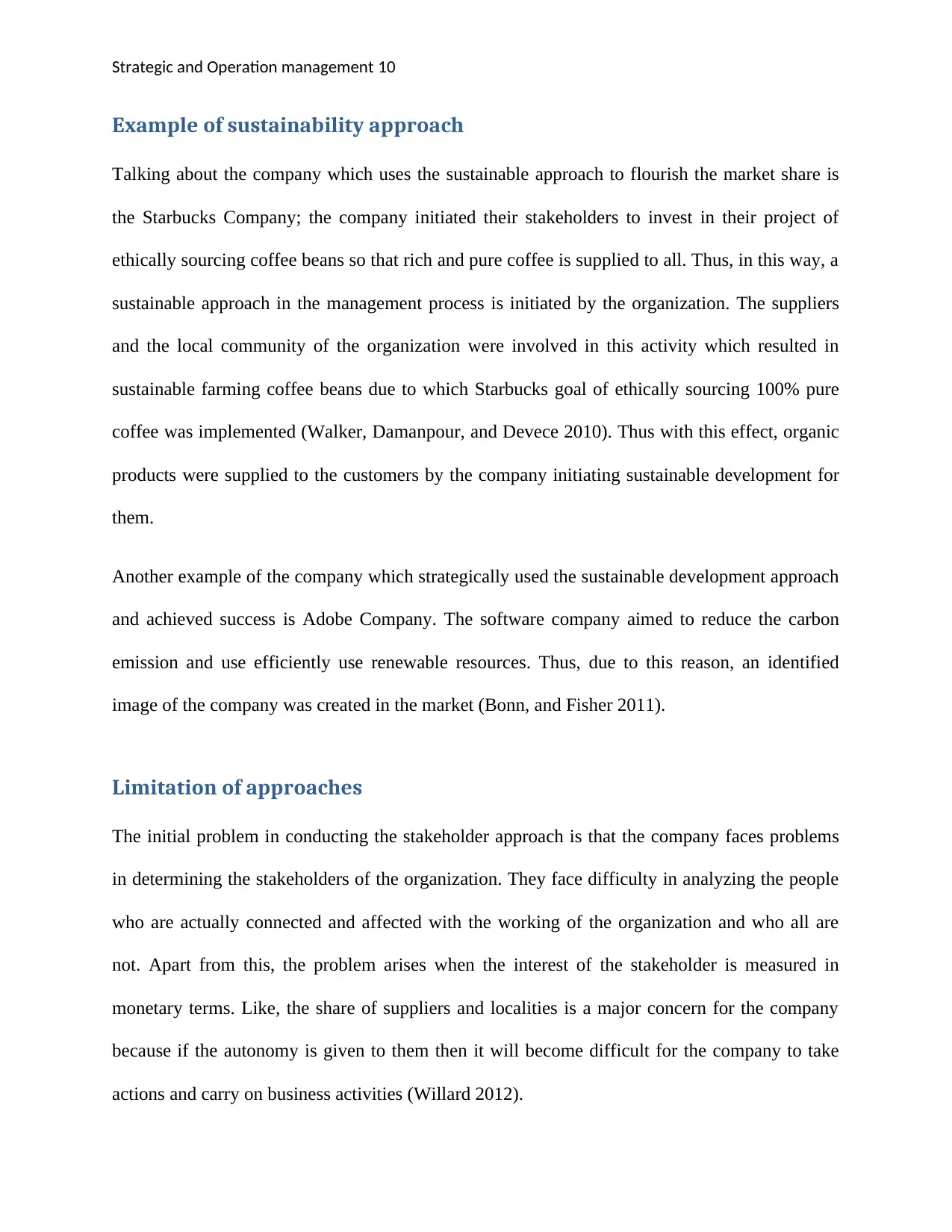
Strategic and Operation management 10
Example of sustainability approach
Talking about the company which uses the sustainable approach to flourish the market share is
the Starbucks Company; the company initiated their stakeholders to invest in their project of
ethically sourcing coffee beans so that rich and pure coffee is supplied to all. Thus, in this way, a
sustainable approach in the management process is initiated by the organization. The suppliers
and the local community of the organization were involved in this activity which resulted in
sustainable farming coffee beans due to which Starbucks goal of ethically sourcing 100% pure
coffee was implemented (Walker, Damanpour, and Devece 2010). Thus with this effect, organic
products were supplied to the customers by the company initiating sustainable development for
them.
Another example of the company which strategically used the sustainable development approach
and achieved success is Adobe Company. The software company aimed to reduce the carbon
emission and use efficiently use renewable resources. Thus, due to this reason, an identified
image of the company was created in the market (Bonn, and Fisher 2011).
Limitation of approaches
The initial problem in conducting the stakeholder approach is that the company faces problems
in determining the stakeholders of the organization. They face difficulty in analyzing the people
who are actually connected and affected with the working of the organization and who all are
not. Apart from this, the problem arises when the interest of the stakeholder is measured in
monetary terms. Like, the share of suppliers and localities is a major concern for the company
because if the autonomy is given to them then it will become difficult for the company to take
actions and carry on business activities (Willard 2012).
Example of sustainability approach
Talking about the company which uses the sustainable approach to flourish the market share is
the Starbucks Company; the company initiated their stakeholders to invest in their project of
ethically sourcing coffee beans so that rich and pure coffee is supplied to all. Thus, in this way, a
sustainable approach in the management process is initiated by the organization. The suppliers
and the local community of the organization were involved in this activity which resulted in
sustainable farming coffee beans due to which Starbucks goal of ethically sourcing 100% pure
coffee was implemented (Walker, Damanpour, and Devece 2010). Thus with this effect, organic
products were supplied to the customers by the company initiating sustainable development for
them.
Another example of the company which strategically used the sustainable development approach
and achieved success is Adobe Company. The software company aimed to reduce the carbon
emission and use efficiently use renewable resources. Thus, due to this reason, an identified
image of the company was created in the market (Bonn, and Fisher 2011).
Limitation of approaches
The initial problem in conducting the stakeholder approach is that the company faces problems
in determining the stakeholders of the organization. They face difficulty in analyzing the people
who are actually connected and affected with the working of the organization and who all are
not. Apart from this, the problem arises when the interest of the stakeholder is measured in
monetary terms. Like, the share of suppliers and localities is a major concern for the company
because if the autonomy is given to them then it will become difficult for the company to take
actions and carry on business activities (Willard 2012).
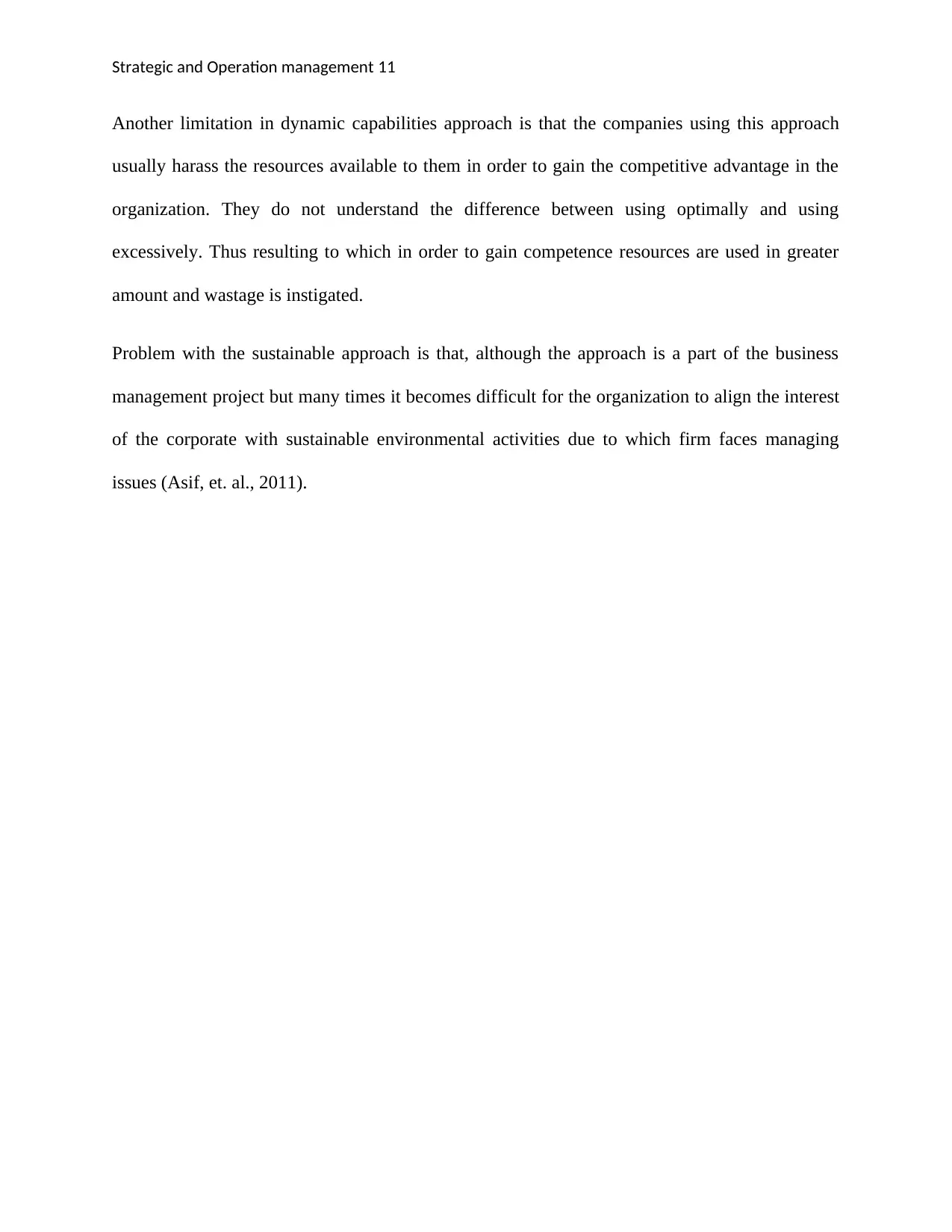
Strategic and Operation management 11
Another limitation in dynamic capabilities approach is that the companies using this approach
usually harass the resources available to them in order to gain the competitive advantage in the
organization. They do not understand the difference between using optimally and using
excessively. Thus resulting to which in order to gain competence resources are used in greater
amount and wastage is instigated.
Problem with the sustainable approach is that, although the approach is a part of the business
management project but many times it becomes difficult for the organization to align the interest
of the corporate with sustainable environmental activities due to which firm faces managing
issues (Asif, et. al., 2011).
Another limitation in dynamic capabilities approach is that the companies using this approach
usually harass the resources available to them in order to gain the competitive advantage in the
organization. They do not understand the difference between using optimally and using
excessively. Thus resulting to which in order to gain competence resources are used in greater
amount and wastage is instigated.
Problem with the sustainable approach is that, although the approach is a part of the business
management project but many times it becomes difficult for the organization to align the interest
of the corporate with sustainable environmental activities due to which firm faces managing
issues (Asif, et. al., 2011).
⊘ This is a preview!⊘
Do you want full access?
Subscribe today to unlock all pages.

Trusted by 1+ million students worldwide
1 out of 16
Related Documents
Your All-in-One AI-Powered Toolkit for Academic Success.
+13062052269
info@desklib.com
Available 24*7 on WhatsApp / Email
![[object Object]](/_next/static/media/star-bottom.7253800d.svg)
Unlock your academic potential
Copyright © 2020–2025 A2Z Services. All Rights Reserved. Developed and managed by ZUCOL.





